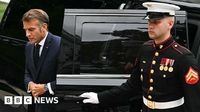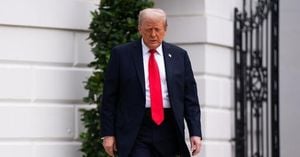On Monday, August 18, 2025, the diplomatic spotlight turned to Washington as Ukrainian President Volodymyr Zelenskyy made a high-stakes return to the Oval Office. This visit, his first since a stormy February encounter with President Donald Trump, was anything but routine. Accompanied by a formidable delegation of European leaders—among them British Prime Minister Keir Starmer, French President Emmanuel Macron, German Chancellor Friedrich Merz, Italian Prime Minister Giorgia Meloni, Finnish President Alexander Stubb, NATO Secretary-General Mark Rutte, and EU chief Ursula von der Leyen—Zelenskyy sought to shore up support for Ukraine at a moment of acute geopolitical tension. The stakes, as both Ukrainian and European officials made clear, could hardly be higher for the future of Ukraine and the security of Europe at large.
The urgency of this gathering was underscored by the events that preceded it. According to BBC and other sources, Trump’s recent summit with Russian President Vladimir Putin in Alaska marked a dramatic shift in U.S. policy. Trump dropped longstanding calls for a ceasefire as a prerequisite for peace talks and signaled an end to further economic sanctions on Russia. These moves—coming after months of Western strategy aimed at containing Moscow—sparked alarm across European capitals. As one European official told BBC, “Things have moved very significantly and quite quickly to a timetable that no one was expecting.”
European leaders scrambled to respond. Macron, who was reportedly enjoying a holiday on the Riviera, and Meloni, who had been in Greece, both cut their vacations short. As BBC noted, Meloni was the first to invite herself to Washington, with Macron and others quickly following suit. Over the weekend, the group held at least five emergency calls to coordinate their strategy. Their goal: to prevent Trump from strong-arming Ukraine into a deal that could amount to capitulation, especially on the contentious issue of territorial concessions in the Donbas region.
Memories of the February Oval Office clash loomed large. During that meeting, Trump, joined by Vice President JD Vance, publicly accused Zelenskyy of being ungrateful for U.S. aid and pressed him to negotiate a swift end to the war. According to AFP, the confrontation turned heated when Zelenskyy warned, “while the United States was currently far from the fighting, you will feel it in the future” if Putin was appeased. Trump bristled: “You don’t know that. You don’t know that. Don’t tell us what we’re going to feel. We’re trying to solve a problem. Don’t tell us what we’re going to feel.” As tempers flared, Vance demanded a public thank you for American support. When Zelenskyy tried to respond, Trump cut him off, saying, “No, no. You’ve done a lot of talking. Your country is in big trouble.”
The fallout was immediate. Zelenskyy left the White House without signing a key mineral rights deal, and the U.S. temporarily suspended military aid and intelligence sharing. European allies, already wary of Trump’s warm words for Putin, feared the worst. But the diplomatic landscape shifted again in the months that followed. Trump, growing frustrated with Moscow’s continued aggression despite U.S. diplomatic overtures, met Zelenskyy at the Vatican in April and later at the NATO summit in The Hague. The two eventually signed the mineral rights agreement, and by mid-August, after another high-profile meeting with Putin, Trump invited Zelenskyy back to Washington and promised to consult both Ukraine and European allies before finalizing any deal with Moscow.
Yet, as the European leaders arrived in Washington, their concerns had only deepened. Trump’s new approach—eschewing demands for an immediate ceasefire and showing little appetite for further sanctions—was seen as dangerously close to Moscow’s preferred terms. Macron was blunt on the eve of the summit: “There is only one state proposing a peace that would be a capitulation: Russia.” European leaders, according to BBC, feared that Trump might push Zelenskyy to accept a land-for-peace deal, particularly in the Donbas, or agree to security guarantees that amounted to little more than verbal assurances.
“Nobody is clear what Trump means about a security guarantee,” one European official told BBC. “He believes that him simply saying to Putin ‘don’t attack’ is enough. That’s not good enough for Ukraine or us.” Instead, the European delegation advocated for a robust, enforceable framework: Ukraine must be allowed to maintain a strong army, with long-term military and financial support from allies, including U.S. weapons and intelligence sharing. Anything less, they argued, would leave not just Ukraine but all of Europe vulnerable to future Russian aggression.
Security guarantees—possibly modeled on NATO’s Article 5, which commits members to mutual defense—emerged as a central topic in the talks. U.S. envoy Steve Witkoff hinted at such arrangements, but European leaders insisted that any deal must be more than a handshake or a signature on paper. As one British diplomat put it, “This is fundamentally about the security of our continent.” The outcome, they stressed, would set a precedent not only for Ukraine but for European security for years to come.
The unity of the European front was not without its challenges. The delegation was, as one official described it, “quite unwieldy,” with disagreements over how much Europe should commit to Ukraine’s long-term security. Some leaders floated the idea of a European-based reassurance force in post-conflict Ukraine, while others urged caution, wary of provoking Trump or appearing to gang up on the U.S. president. The risk, as BBC noted, was that pushing too hard might lead Trump to feel bullied—potentially causing the talks to collapse.
As the day unfolded, the leaders sought to slow down fevered speculation about land-swap deals and instead focus on the broader principles of any future settlement. Progress was sought on organizing a trilateral summit between Trump, Zelenskyy, and Putin, as well as laying the groundwork for “talks about talks” that could eventually lead to a formal negotiation—ideally only after some form of ceasefire had been agreed.
Meanwhile, the situation on the ground in Ukraine remained dire. Zelenskyy highlighted ongoing Russian attacks on cities like Kharkiv and Zaporizhzhia, underscoring the urgent need for meaningful security guarantees. Ukrainian lawmakers warned that any territorial concessions would send a dangerous signal to Moscow that further expansionism might go unpunished, threatening not only Ukraine’s sovereignty but the stability of the entire region. Macron echoed these concerns, warning that a weak Western response now could embolden Russia and ignite future conflicts across Europe.
As the meetings drew to a close, it was clear that the outcome would have far-reaching consequences. The assembled leaders faced a delicate balancing act: supporting Ukraine’s sovereignty, maintaining European unity, and navigating the unpredictable currents of Trump’s diplomacy. The decisions made in Washington this week, for better or worse, would shape the future of European security and the fate of Ukraine for years to come.





